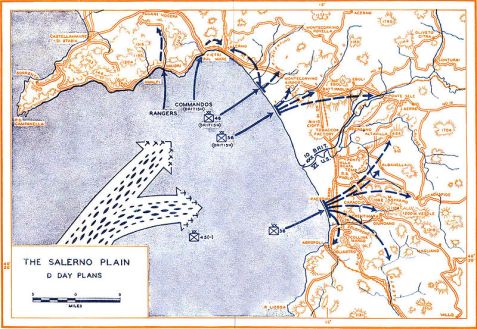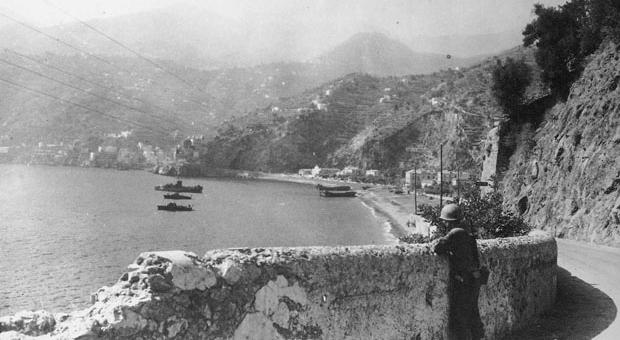by Francesca Gallotta
L’8 settembre 1943, il maresciallo Pietro Badoglio, subentrato alla guida del governo dopo il voto di sfiducia del Gran Consiglio del Fascismo nei confronti di Mussolini, annunciò all’Italia l’armistizio con gli Alleati tramite l’EIAR (Ente Italiano per le Audizioni Radiofoniche). La notizia si diffuse rapidamente anche tra la popolazione salernitana. Ma la guerra era davvero finita? Sembrava un’affermazione fin troppo semplice da fare.

Il 9 settembre 1943, il generale Clark, comandante della Quinta Armata statunitense e delegato dal generale Eisenhower, diede il via allo Sbarco di Salerno. L’operazione militare, chiamata “Avalanche”, fu attuata dagli Alleati con l’obiettivo di aprire un nuovo fronte nel conflitto, da cui lanciare l’offensiva contro i territori controllati dall’Asse. L’operazione nel golfo salernitano ebbe un’importanza straordinaria, con una flotta che comprendeva mille navi e circa 160.000 soldati, numeri simili a quelli impiegati nel 1944 durante lo Sbarco in Normandia, che coinvolse tra i 160.000 e i 180.000 soldati. Questo sbarco, per importanza, venne superato nel 1944 proprio dall’invasione della Normandia.
La scelta di Salerno, in particolare i territori limitrofi della Piana del Sele, fu un compromesso dettato dall’impossibilità di attaccare il ben difeso e controllato porto di Napoli. Le prime navi iniziarono lo sbarco sul litorale salernitano alle 3:30 del 9 settembre, lungo una fascia costiera che si estendeva per circa sessanta chilometri, da Maiori, nella costiera amalfitana, ad Agropoli, nel Cilento. La battaglia tra le forze alleate, comandate dal generale Clark, e le truppe tedesche, sotto il comando del generale Albert Kesselring, fu tutt’altro che semplice, durando settimane e coinvolgendo anche la popolazione civile. Nonostante fossero in netta inferiorità numerica, i tedeschi non si arrendettero, opponendo una potente resistenza che rallentò anche le truppe anglo-americane, grazie soprattutto alla loro conoscenza del territorio.

L’arrivo delle truppe alleate a Maiori, nella Costiera Amalfitana Dopo giorni di combattimenti estenuanti, le truppe alleate, ormai stanche e provate, iniziarono una controffensiva, facendo arrivare una nave dalla base di Malta con l’intento principale di bombardare la costa salernitana e attaccare simultaneamente via aerea, seminando scompiglio tra le forze tedesche. Grazie alla collaborazione e alla determinazione delle forze alleate, la controffensiva si rivelò decisiva per il successo dell’intera operazione.
“Avalanche” si concluse definitivamente il 1° ottobre 1943, quasi un mese dopo lo sbarco, con l’arrivo del generale Clark e della sua armata nel porto di Napoli, obiettivo principale delle forze alleate, ormai liberata dai tedeschi grazie a un’insurrezione popolare che passò alla storia come le “Quattro Giornate di Napoli”. L’operazione e gli scontri avevano lasciato profonde cicatrici sul territorio salernitano: tutta la zona era stata teatro di intensi combattimenti e città come Battipaglia, Sarno e Scafati erano state praticamente distrutte.
A partire da ottobre, lo scontro con i tedeschi si spostò verso il nord della penisola, segnando l’inizio di una lunga e ardua marcia verso la Liberazione. Dietro di sé, le truppe lasciavano macerie, lutti, una popolazione esausta a causa della fame e delle continue battaglie, e rapporti con i vincitori non sempre facili a causa delle enormi differenze culturali e delle difficoltà legate all’occupazione.
ENGLISH VERSION: OPERATION AVALANCHE 9TH OF SEPTMBER 1943
On 8 September 1943, Marshal Pietro Badoglio, who took over the leadership of the government after the vote of no confidence by the Grand Council of Fascism against Mussolini, announced to Italy the armistice with the Allies through EIAR (Italian Agency for Radio Hearings). The news spread quickly even among the population of Salerno. But was the war really over? It seemed too easy a statement to make.
On 9 September 1943, General Clark, commander of the US Fifth Army and a delegate of General Eisenhower, launched the Salerno Landing. The military operation, called “Avalanche”, was carried out by the Allies with the aim of opening a new front in the conflict, from which to launch the offensive against the territories controlled by the Axis. The operation in the gulf of Salerno had an extraordinary importance, with a fleet that included one thousand ships and about 160,000 soldiers, numbers similar to those used in 1944 during the Normandy Landings, which involved between 160,000 and 180,000 soldiers. This landing, although the largest in history, was surpassed in 1944 by the invasion of Normandy.
The choice of Salerno, in particular the neighboring territories of the Sele plain, was a compromise dictated by the impossibility to attack the well-defended and controlled port of Naples. The first ships began landing on the coast of Salerno at 3:30 on 9 September, along a coastal strip that extended for about sixty kilometers, from Maiori, in the Amalfi coast, to Agropoli, in the Cilento. The battle between the allied forces, commanded by General Clark, and the German troops, under the command of General Albert Kesselring, was anything but simple, lasting weeks and involving even the civilian population. Although they were clearly outnumbered, the Germans did not surrender, and offered a powerful resistance that also slowed down the Anglo-American troops, thanks mainly to their knowledge of the territory.
The arrival of the allied troops at Maiori, in the Amalfi Coast After days of exhausting fighting, the Allied troops, now tired and tried, began a counter-offensive, Bringing in a ship from the base of Malta with the main intention to bomb the coast of Salerno and attack simultaneously by air, wreaking havoc among the German forces. Thanks to the cooperation and determination of the allied forces, the counteroffensive proved decisive for the success of the entire operation.
“Avallanche” ended definitively on October 1, 1943, almost a month after the landing, with the arrival of General Clark and his army in the port of Naples, main target of the allied forces, Now liberated by the Germans thanks to a popular uprising that went down in history as the “Four Days of Naples”. The operation and the clashes had left deep scars on the territory of Salerno: the whole area had been the scene of intense fighting and cities such as Battipaglia, Sarno and Scafati had been practically destroyed.
From October onwards, the clash with the Germans moved to the north of the peninsula, marking the beginning of a long and arduous march towards liberation. Behind them, the troops left rubble, loss, a population exhausted by hunger and continuous battles, and relations with the victors not always easy because of the enormous cultural differences and difficulties related to the occupation.


Bibliografia:
A. Capano e A. Lampugnani, Eboli, Il Saggio, 2014, pag.25. Memorie di guerra. Il Cilento e il Salernitano prima, durante e dopo l’operazione Avalanche.
J. Miller, Univesity of North Carolina,1986, The United States and Italy 1940-1950: The Politics and Diplomacy of Stabilization
A. Pesce, Salerno 1943. Operation Avalanche, Albertelli, Parma, 1996
A. G Steiger., The Campaign in Southern Italy (September-December 1943)
Sitografia:
https://www.focus.it/cultura/storia/9-settembre-1943-lo-sbarco-a-salerno
https://www.comune.napoli.it/flex/cm/pages/ServeBLOB.php/L/IT/IDPagina/15366
http://www.archiviodistatosalerno.beniculturali.it/Risorse/scaricabili/schegge.pdf
http://www.me-dia-re.it/alleati-sbarcano-salerno-09-09-1943/